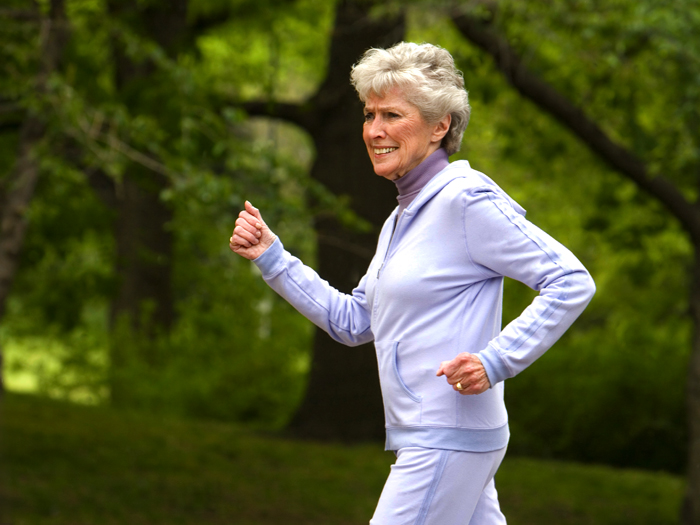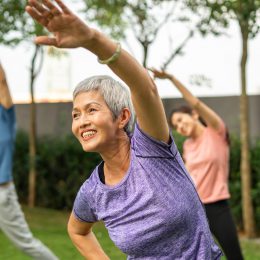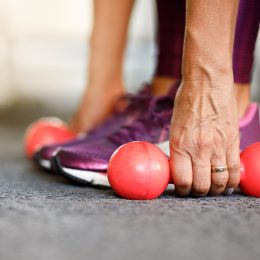6 Simple Ways to Burn More Calories Walking
Transform your leisurely stroll into a calorie-blasting workout with these small changes.

Walking doesn’t get the respect it deserves.
Putting one foot in front of the other may seem easy, but those steps can quickly add up to help your heart, lungs, muscles, bones, and brain stay healthy for the long haul. And with a few simple strategies, you can transform a leisurely stroll into a calorie-blasting workout—without spending more time on your feet.
The key is taking your body out of autopilot and infusing some variety into your steps, says Carolyn Appel, C.S.C.S., a personal trainer in New York City.
“By changing the variables of your walk, you will cause the body to work harder and consequently burn more calories.”
Next time you head out for a walk, amp up your calorie burn by working any or all of these strategies into your route.
1. Walk Like a Superhero
In today’s modern world, we’re often leaning forward over a computer screen or looking down at our phones, taking our body out of its natural positioning. The result: shoulders that rotate inward and a head that hangs forward—not good posture.
Poor posture isn’t just linked to muscle pain. It can also negatively impact bodily functions, such as breathing, blood flow, and digestion, says Terecita “Ti” Blair, a SilverSneakers instructor in Denver.
Walking with your chest high and your shoulders back can optimize movement, helping your body work at its full potential, she says. And since you’re engaging more muscles, you’ll up your calorie burn too.
On your next walk, imagine there’s a string coming straight out from your chest—right where Superman’s “S” would be—that someone a few feet in front of you is pulling. Keep your eyes forward, and your shoulders down and back, as if you’re holding a ball between your shoulder blades. It might feel awkward at first, but you’ll quickly adapt to the more confident stride.
2. Change Your Direction
We move in one plane of motion all day long: forward. Walking sideways or backward works your body in new ways, says Michele Olson, Ph.D., a senior clinical professor of sport science at Huntingdon College in Montgomery, Alabama.
Your body is less familiar with these patterns, so you can expect to get more cardiovascular and calorie-burning benefits in a shorter amount of time, she says.
Sideways or backward walking can also help increase strength in leg muscles that you use less often, improve balance and coordination, and enhance your sense of body awareness.
If you don’t have any balance issues and have clear space for walking, try incorporating 30-second intervals of walking sideways or backward every two to three minutes.
For sustained backward walking, the treadmill is a safer option. Use the handrails for support, and start with the treadmill at a slow speed (1 mph). Once you’re comfortable on the belt, you can gradually work up to a brisk walk (3 mph) for 10 to 15 minutes. If you ever feel out of control, bring the speed down or pause your workout. Safety always comes first.
3. Try to Beat the Traffic Lights
Many major cities have pedestrian traffic lights timed to allow a person to cross an intersection while walking at a pace of 3.5 feet per second (or about 2.4 mph).
One problem: Many people walk slower than this, Appel says. “Being able to walk quickly is a critical life skill, and the more you practice it, the more you can count on it being there when you need it.”
Plus, increasing speed increases intensity, and that burns more calories, Appel says.
In fact, a study from Ohio State University found varying your walking speed may burn up to 20 percent more calories than walking at a steady pace. Changing speed is like “pressing the gas pedal,” the researchers say, and any change requires more effort from the legs.
Help yourself walk safely in pedestrian crossings—and anywhere—by adding bouts of speed to your routine. Whether you’re walking in a safe outdoor space, at an indoor track, or on a treadmill, try working in 15 to 20 seconds of fast walking every one to two minutes followed by slower walking for recovery.
4. Seek a Softer Surface
A little lesson in physics: “On a hard surface like pavement, you move forward because you’ve just pushed into the ground and the ground pushes an equal and opposite force back into you,” Appel explains.
On a softer surface like sand, there’s less pushback. Your foot and body have to work harder on each step, she says.
Subscribe to our newsletter
It's quick and easy. You could be one of the 13 million people who are eligible.
Already a member? Click to discover our 15,000+ participating locations.
Follow Us
“Even going onto the grass next to a hard path will be more challenging,” Appel says. “And your joints will thank you too.”
5. Swing Those Arms
The easiest way to upgrade your walking workout is to get your upper body involved. Swinging your arms as you walk will help increase your speed—and burn more calories.
How to do it: Bend your elbows 90 degrees. Keeping your elbows close to your body, swing your hands from your waist to your chest. Keep your arms moving forward and backward. Don’t let your hands go across your body, which will slow you down.
6. Add Skipping or Squat Walking
Burning more calories on your walk means moving in a way that’s new or unnatural to you, Appel says. Skipping or squat walking likely fits the bill.
Skipping for 30 seconds a few times throughout your walk ramps up heart rate and burns more calories, Blair adds. And if you feel a little silly doing it, it might work to your advantage. Research suggests laughing burns additional calories—up to 10 calories per 10 to 15 minutes.
As for the squat walk, bending your knees and walking in a squat position every few minutes will engage more of your quads, including areas that tend to be underused during normal walking, Olson says.
“The quads are larger muscles so engaging them burns more calories,” she says.
If you have osteoporosis, arthritis, diabetes, or injuries, talk to your doctor before doing skips or squat walks. Luckily, with so many other options to turn up the calorie burn, you can still get a great walking workout.
Take Your Favorite SilverSneakers Classes Online!
SilverSneakers members can access live fitness classes and wellness workshops through SilverSneakers LIVE. See the latest schedule and RSVP for classes here.
Not a member? If you have a Medicare Plan, it may include SilverSneakers—at no additional cost. Check your eligibility instantly here.





